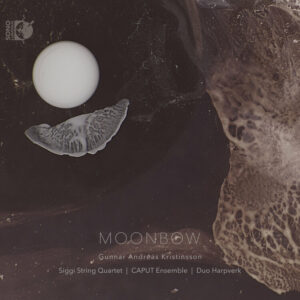Gunnar Andreas Kristinsson
Moonbow
Sono Luminus CD
Caput Ensemble
Icelandic composer Gunnar Andreas Kristinsson’s second CD, Moonbow, presents a selection of pieces written during the past decade for sinfonietta and chamber forces. Clarinetist Ingólfur Vilhjálmsson joins Caput Ensemble, conducted by Guðni Franzson, in Sisyphos. Written in 2014, this is the composer’s most acclaimed piece, and one can readily hear why. Based on the mythological tale of the title character ceaselessly rolling a boulder up a hill as punishment in Hades, the concerto features eruptive outbursts, virtuoso solo turns, a middle section of minimal repetitions, and a closing danse macabre.
Patterns IIb, for violin, bass clarinet, and percussion (mostly mallets) is a set of variations on the Icelandic folksong “Fagurt er í Fjörðum” providing a further exploration of ostinato. Kristinsson adopts the patterning of minimalism, but uses a collection of semitones to construct a chromatic pitch structure that prioritizes semitones. Passacaglia B is a trio for bass clarinet, harp, and percussion, the bass melody traded between all the instruments – the percussion once again featuring mallets – and overlaid with differently paced repeating melodic patterns in the alto and treble registers. The passacaglia itself infiltrates the upper register at times, leaving the bass clarinet to take up a scurrying low register melody.
The Siggi String Quartet have been stalwart advocates of Icelandic composers, and their performance of the CD’s title work is no exception. Moonbow refers to a lunar or “white” rainbow. Sustained cello melodies ground syncopated upward directed repeating phrases. Again, there is a confluence of chromaticism and minimalism distinctive in its deployment. A poignant slow section arrives near the end of the piece, with yearning melodies offset by pizzicatos. This proves to be an interlude rather than a coda, as the patterned passages return, now juxtaposed against the plucked strings. The dynamic and intensity build to a double-time, but harmonically unresolved, finish.
Roots is a three movement ensemble work based on spectralism. The “roots” in question are fundamentals of the overtone series. The first movement uses only one series, the second movement uses multiple series that shift into and out of focus. In the final movement, melodies are crafted from the upper partials of the series, with microtonal shadings used to better replicate their tunings. This is a well trod, but durable, version of microtonality, and it provides a contrasting approach to the other pieces on the CD, one that Kristinsson might profitably further examine. Moonbow demonstrates consummate craftsmanship in winning performances. Recommended.
- Christian Carey

